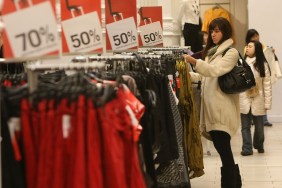And it shows: The designer’s Spring 2014 collection (composed of organic cottons and silks cut into feather-light, playfully feminine separates) received unambiguous praise from every fashion outlet that sent a reviewer. As one tFS forum member said at the time, “[I] would definitely put this in my top ten for New York and the big shows haven’t even happened yet.”
Organic by John Patrick marries exceptional design and commercial appeal with a strong ethical component, something which many brands strive towards, but few have truly mastered. And today, we’re thrilled to announce that the label has received the Honorary Award for Ethical Fashion as part of the first annual tFS Style Awards.
Below, John Patrick talks about his eco-approach to design, why cause marketing doesn’t work and what it would take for the fashion system to change.
theFashionSpot: People are becoming inceasingly concerned about the ethical dimension of fashion, but you’ve been operating your business according to ‘eco-friendly’ practices for over a decade. When you first started out, were there many other designers pursuing transparent sourcing and production?
John Patrick: I basically started to do the research and the development in 2002 and 2003. So, no. At that point, we’d just moved into a new millennium and there was a lot of confusion in the underlying parts of the industry, and there was very little direction.
At the end of the last century, there was a handful of visionary designers that were working to change a silhouette, to change the way that fashion actually appeared on the surface — but as far as the deeper digging, what I call the archaeology of fashion, it hadn’t really been addressed since the 80s, when Suzy Tompkins [Buell] and maybe Katharine Hamnett had brought the conversation to the table. But then of course, the 90s happened. And then it got swept under the carpet. Every generation and every decade has its difficulties and it has its challenges; it has the movements, it has the trends, it has an overnight explosion — boom, boom, here I am! wow, look at me! But right now in our industry, in the design world, there are hundreds and hundreds of thousands of brands and companies and designers all trying to chase after attention. So it makes it even more difficult, sometimes, for some voices to be heard — those that choose not to promote or advertise.
So what happened in the past couple of years is that the large corporations, they figured out that they could get a little temporary lift by pulling on people’s heartstrings — you know, cause marketing. Cause marketing is not sincere, it actually has a detrimental effect on the internal marketplace of supply and demand because it creates false demand and false hopes within the supply channels. So when people say, “We’re going to do a program with, say, organic cotton. We’re going to make it a big, huge promotion. It’s going to be a huge push. We’re going to use 100 million pounds of organic cotton!” Well, there isn’t 100 million pounds of organic cotton available. So they create this false bubble and then the supply community — whether it’s the farmers, the spinners, the weavers — thinks, “Well, if we need 100 million pounds of organic cotton this year, then we’ll certainly need 120 million pounds of organic cotton next year.” Well no, that’s not true! Because it’s a big corporation that’s really just doing it because they felt that it was on-trend. And then the market goes back down. And then the farmers and suppliers are less inclined to make the commitment the next go-around, because they got burned once already.
What we have to look forward to in the coming decade will be extreme transparency in a certain part of the industry. That is both good and bad, because it creates this false sense of a reality sometimes for the bigger brands, they think — “Oh look at Patagonia! Great business model! Yeaah, we really want to do something like that!” But they only want to do it at the top of their pyramid, which is 1/100th of one percent. So it’s meaningless! But spin and the consumer, they don’t really get that. Because the poor consumer is always the victim. The consumer always gets blamed. They’re not thanked for the support…”The customer should know,” is what a lot of people say and that’s the exact opposite of what should be happening. We have to revere the customers that appreciate good and ethical design — not hoodwink them! Corporations manipulate consumers because they have to meet the bottom line. They have to pump up those numbers. I basically don’t concern myself with any of that stuff because we don’t participate in any of it anymore. We just have our customers, our retail partners. And we stay true to the aesthetic of our brand, to the ethical aspect of it. But also, it’s fashion first. And we spin fashion first. Even though, initially, when we started to talk about organic and ethical and sustainable textiles and recycled textiles in 2004/2005/2006, people didn’t really know what I was talking about.







